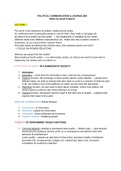POLITICAL COMMUNICATION & JOURNALISM
Notes by Asiah Capponi
LECTURE 1
Pol comm is the interaction bt politics, media and the public
Ex. politicians want to persuade people to vote for them, they make a campaign etc.
No direct line bt politics and the public → this relationship is mediated by the media
Different media have different characteristics (ex. Twitter also has a certain number of
characters, so you cannot write a speech there)
One actor wants something from another actor, who exercises power over who?
→ FOCUS ON POWER RELATIONS
What do we expect from the media?
(free) media as fourth estate → in a democratic society, as citizens we want to know what is
happening, the media's job is to inform us
FUNCTIONS OF MEDIA IN A DEMOCRATIC SOCIETY:
1. Information
2. Education → what does the information mean, what are the consequences
3. Platform function: the exchange of ideas (public sphere, public debate) → people have
different ideas, we need to interact with each other to come to a solution of what we want
to do, the media is one of the platforms on which we can have this discussion
4. Watchdog function: we also need to learn about scandals, control over politics, the
media needs to publicize also what politicians do wrong
5. Channel function: ideological opinions need to find their way to people → political actor
express their ideas to the public
ROLE OF JOURNALISTS (David Weaver)
1. Disseminator of information
2. Interpreter: explain the information
3. Adversarial: versus politicians and business
4. Populist mobilizer: mobilizing people
THREATS TO PERFORMING THESE FUNCTIONS
1. Commercialization, leading to decreased news quality → Media Logic → goal become
maximizing the audience and the profit, as a consequence sensational news with
elements of entertainment
Lower quality→ people can get news for free online, business models of traditional
journalism fail, consequences: budget cuts, market logic takes over, increased
competition for audience’s attention
, Which functions are threatened?
● Informational: less information
● Education: less, costs money
● Platform function under pressure due to decreased pluralism (if there are only
two major newspapers, there are less opinions out there that can be debated)
2. Political actors gain control over media content
Political Parallelism= the idea that political parties work in parallel with news channels
Government control over media content (ex. Berlusconi)
Own media channels, radio, TV → becomes Prime Minister → has control over the
media and what they say, selective government advertisements, political decisions over
the newsroom, censorship
Which functions are threatened?
● Info and edu: possible bias
● Platform: highly threatened, pluralism
● Watchdog: highly threatened
3. Journalists getting stuck into safe routines, focus on elite opinions (INDEXING)→
solution: different approach to journalism
Spinning: presenting the same issue in a different way
4. Information processing by the public: Videomalaise → watching info on TV has a
negative effect on the public (ex. Cynicism, low trust in politics) → “dumbing down”:
people are not able to process political information
MEDIATIZATION
A process, not necessarily unidirectional
All the info you get becomes more dependent on the media
● First phase: mediation = the media becomes the main communication channel bt politics
and public
● Second phase= media becomes more independent, it does not mediates message
unconditionally (it does not simply say something because a politician said it)
● Third phase= media become so independent that other actors need to adapt to it
(politicians need to follow the format, content and rhythm of the media so that they can
have a higher chance to make news), used certain media strategies because you know
they will work
● Fourth phase= politicians don’t only adapt but they adopt the media logic, media are no
longer external, it becomes a tool used and known by politicians because they can use it
to get attention, political policies are made/changed based on what a politician thinks will
be news-worthy, more talked about or discussed upon
MEDIA LOGIC= the media needs to operate as a business, presenting attractive news, the
public is perceived as a consumer, the routine of how journalists get their news
MEDIA SYSTEMS
, Polarized Pluralist Model
● Late democratization, strong politicization
● Low readership → elite oriented press
● High political parallelism
● Low professionalization
● Strong state intervention to control
Ex. Greece, Italy, Spain
Democratic Corporatists
● Strong organized social groups
● Census democracies
● High readership and strong professionalization
● Strong state intervention as funder and protector
Ex. Austria, Belgium, Denmark
Liberal Model
● High readership
● Strong professionalization
● Neutral, but highly commercialized press
● Pluralism is internal
● Market-dominated, weak state intervention
Ex. USA, Britain, Canada
“NEWS ECOSYSTEM” STUDY
Print vs Online news
1st finding: most online news are copies of print traditional news
2nd finding: print media published less stories in the last decade compared the previous → bc
people read less print
→ there is less diverse content
5 WAYS IN WHICH A GOVERNMENT CAN SUPPORT JOURNALISM (Plessing)
1. Subsidizing: supporting financially production costs
2. Cooperation schemes: small newspapers can use the printing of bigger newspapers
3. Cut taxes for newspapers




